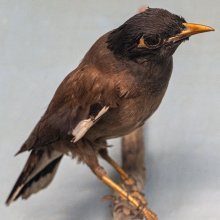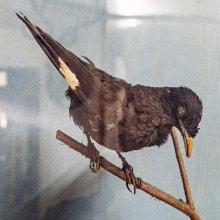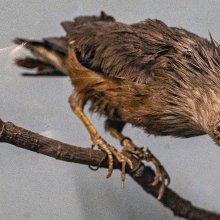Myna, Mynah: 2 definitions
Introduction:
Myna means something in Buddhism, Pali, Hinduism, Sanskrit. If you want to know the exact meaning, history, etymology or English translation of this term then check out the descriptions on this page. Add your comment or reference to a book if you want to contribute to this summary article.
Images (photo gallery)
In Hinduism
Purana and Itihasa (epic history)
Source: Shodhganga: Elements of Art and Architecture in the Trtiyakhanda of the VisnudharmottarapuranaMynas and Parrots were traditionally trained (to speak and sing), as part of the “sixty four kinds of Art”, according to the Kamasutra of Vatsyayana.—Cf. the Sanskrit Śukasārikāpralāpana.—Indian tradition, basically includes sixty four Art forms are acknowledged. The history of Indian Art covers approximately five thousand years which presents a rich and almost continuous record. The references of sixty four kinds of Kala (कला, kalā) are found in the Bhagavatapurana, Shaiva-Tantras, Kamasutra of Vatsyayana etc.

The Purana (पुराण, purāṇas) refers to Sanskrit literature preserving ancient India’s vast cultural history, including historical legends, religious ceremonies, various arts and sciences. The eighteen mahapuranas total over 400,000 shlokas (metrical couplets) and date to at least several centuries BCE.
In Buddhism
Tibetan Buddhism (Vajrayana or tantric Buddhism)
Source: academia.edu: The Structure and Meanings of the Heruka MaṇḍalaThe Myna (animal) is associated with the Yoginī (female deity) named Sārikā, being situated in the Vāyucakra, according to the 10th century Ḍākārṇava-tantra: one of the last Tibetan Tantric scriptures belonging to the Buddhist Saṃvara tradition consisting of 51 chapters.—Accordingly, the vāyucakra refers to one of the three divisions of the dharma-puṭa (‘dharma layer’), situated in the Herukamaṇḍala. The 36 pairs of Ḍākinīs [viz., Sārikā—“Myna”] and Vīras are dark blue in color; they each have one face and four arms; they hold a skull bowl, a skull staff, a small drum, and a knife.

Tibetan Buddhism includes schools such as Nyingma, Kadampa, Kagyu and Gelug. Their primary canon of literature is divided in two broad categories: The Kangyur, which consists of Buddha’s words, and the Tengyur, which includes commentaries from various sources. Esotericism and tantra techniques (vajrayāna) are collected indepently.
See also (Relevant definitions)
Starts with: Mynaachedi, Mynachedi.
Full-text (+39): Sharika, Shalika, Shari, Kamalli, Janamki, Nankanaiccan, Cerukam, Kadalegoravamka, Calamki, Nanuvam, Shuka, Metavini, Kadumaina, Canaki, Nakanavayppul, Kurakam, Madan, Kundalini, Maina, Shar.
Relevant text
Search found 13 books and stories containing Myna, Mynah; (plurals include: Mynas, Mynahs). You can also click to the full overview containing English textual excerpts. Below are direct links for the most relevant articles:
The Nature of Light is Ferocity < [July 1966]
The Nature of Light is Ferocity < [July 1966]
Indian Rain < [June 1946]
Bhagavad-gita-mahatmya (by Shankaracharya)
Animal Kingdom (Tiryak) in Epics (by Saranya P.S)
The Catu-Bhanavara-Pali (critical study) (by Moumita Dutta Banik)
The fourth Bhanavara (Introduction) < [Chapter 5 - Subject Matter of the Fourth Bhanavara]
Charaka Samhita (English translation) (by Shree Gulabkunverba Ayurvedic Society)
Chapter 27c - The group of meats (Mamsa) < [Sutrasthana (Sutra Sthana) — General Principles]
Chapter 12 - Prognosis from Powder resembling Cow-dung Powder (gomaya-curna) < [Indriyasthana (Indriya Sthana) — Section on Sensorial Prognosis]
Chapter 12 - The remaining best kinds of Enema (uttara-basti-siddhi) < [Siddhisthana (Siddhi Sthana) — Section on Successful Treatment]
Vishnudharmottara Purana (Art and Architecture) (by Bhagyashree Sarma)
3. A General Note on Art < [Chapter 1 - Introduction]


